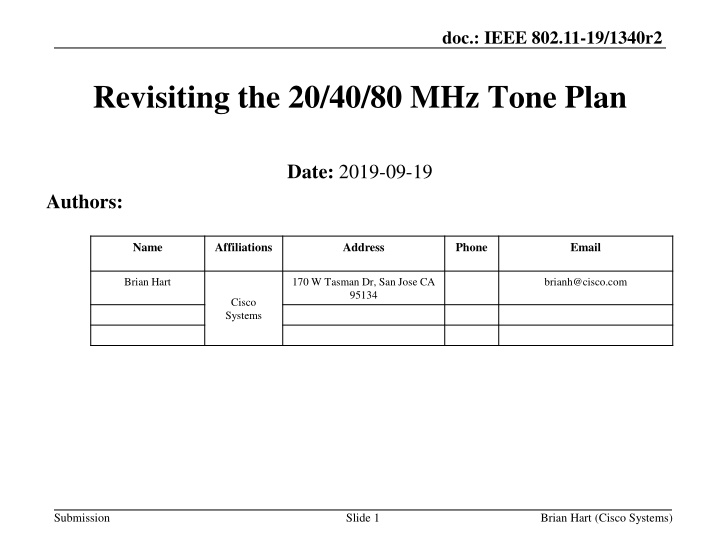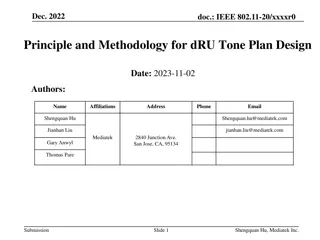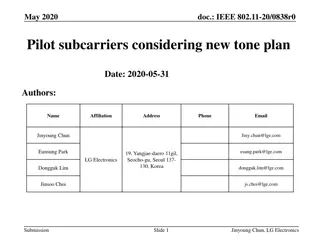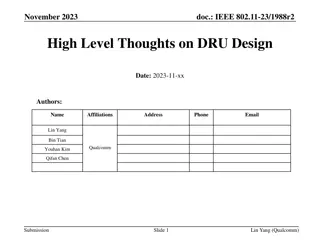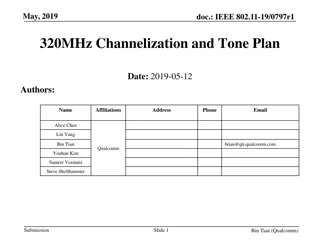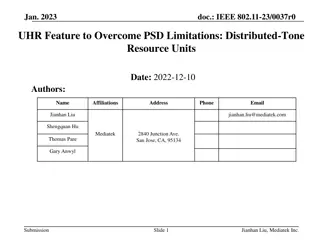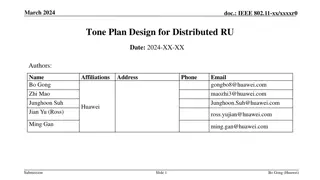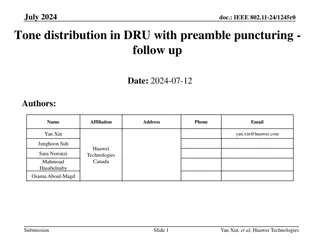Revisiting the IEEE 802.11-19/1340r2 Tone Plan Optimization
Revisiting the tone plan optimization for IEEE 802.11-19/1340r2, addressing issues with RUs near band edges, accommodating various STA bandwidth capabilities, and the inefficiencies of non-SST 11ax STAs in different BSS scenarios. Proposals include adapting to unknown future 11ax features, minimizing spectrum wastage, and the necessity for 11be devices to support both 11ax and 11be tone plans.
Download Presentation

Please find below an Image/Link to download the presentation.
The content on the website is provided AS IS for your information and personal use only. It may not be sold, licensed, or shared on other websites without obtaining consent from the author.If you encounter any issues during the download, it is possible that the publisher has removed the file from their server.
You are allowed to download the files provided on this website for personal or commercial use, subject to the condition that they are used lawfully. All files are the property of their respective owners.
The content on the website is provided AS IS for your information and personal use only. It may not be sold, licensed, or shared on other websites without obtaining consent from the author.
E N D
Presentation Transcript
doc.: IEEE 802.11-19/1340r2 Revisiting the 20/40/80 MHz Tone Plan Date: 2019-09-19 Authors: Name Affiliations Address Phone Email Brian Hart 170 W Tasman Dr, San Jose CA 95134 brianh@cisco.com Cisco Systems Submission Slide 1 Brian Hart (Cisco Systems)
doc.: IEEE 802.11-19/1340r2 Situation A 11ax developed a tone plan optimized for throughput and the presence of the central RU26, with one distinct tone plan per bandwidth At the development time, certain ultimate 11ax features were unknown, unclear or TBD: 20 MHz-only STAs STAs reducing their BW for power savings Preamble-puncturing This tone plan is implemented in all 11ax devices 802.11 has performed do-overs in the past e.g. 11ac simplified the pilot tone design wrt 11n Submission Slide 2 Brian Hart (Cisco Systems)
doc.: IEEE 802.11-19/1340r2 Problem A Certain RUs are close to a band edge or near a DC tone, and these RUs are unavailable to: 20 MHz-only STAs STAs reducing their BW for power savings Preamble-puncturing (edge RUs only) i.e. very difficult for a scheduler to allocate For example, for each row of the figure, when these RUs are unallocated, there is an efficiency loss of [19 24 35 2.5 2.5 0]% Conversely, any new plan without these disadvantages will be a new tone plan, so 11be devices must implement both 11ax and 11be tone plans Submission Slide 3 Brian Hart (Cisco Systems)
doc.: IEEE 802.11-19/1340r2 Situation B A 20 MHz-only STA or 20 MHz operating STA may support SST whereupon it can occupy any 20 MHz and can participate in the TX/RX of OFDMA PPDUs of any bandwidth A normal STA operating with 80 MHz bandwidth can participate in the TX/RX of OFDMA PPDUs of 80/160/80+80 MHz A normal STA may support SST where it can occupy any 80 MHz within 160/80+80 MHz A 20 MHz-only STA or 20 MHz operating STA that does not support SST can participate in the TX/RX of some RUs in the P20 of an OFDMA PPDU of any bandwidth A normal 11ax STA operating with 40 MHz bandwidth can only participate in the TX/RX of OFDMA PPDUs of 20/40 MHz bandwidth Submission Slide 4 Brian Hart (Cisco Systems)
doc.: IEEE 802.11-19/1340r2 Problem B Normal non-SST 11ax STAs operating with a 20 or 40 MHz bandwidth in an 80/160/80+80 MHz BSS are hugely inefficient, and their impact will worsen with 11be An SU or MU transmission involving the STAs in an 80 MHz BSS wastes 60 or 40 MHz of spectrum respectively An SU or MU transmission involving the STAs in an 160/80+80 MHz BSS wastes 140 or 120 MHz of spectrum respectively An SU or MU transmission involving the STAs in a 320/160+160 MHz BSS wastes 300 or 280 MHz of spectrum respectively This is a side-effect of the 11ax tone plan: it s a lot more complicated to schedule 20 or 40 MHz operating devices in an 80/160/80+80 MHz PPDU, and not-quite-trivial to receive an 80/160/80+80 MHz PPDU when operating in 20 or 40 MHz Schedule 20M SST & 80MHz operating STAs Schedule 20MHz non-SST STAs when dominant: 60+ MHz wasted Schedule 20MHz SST & 40MHz operating STAs: 40+ MHz wasted 20 MHz non-SST 20 MHz non-SST 20 MHz non-SST Submission Slide 5 Brian Hart (Cisco Systems)
doc.: IEEE 802.11-19/1340r2 Solution: Design Principles Seek a streamlined tone plan with a very high degree of reuse For different bandwidths With respect to 11ax Design a tone plan for a 20 MHz tile and replicate it to 40 and 80 MHz Works equally well for 80+80, 160, 160+160 MHz and so forth To support RXs with 20/40/80 MHz BWs centered on any 20/40/80 MHz channel, The tone plan includes DC tones every n*10 MHz, The tone plan generally avoids RUs that near a 20 MHz boundary To avoid inefficiency, a new RU, RU18, is defined to occupy the otherwise-unused subcarriers between the 20 MHz tiles Not used at the band-edge Still has room for 5 DC subcarriers for 40 and 80 MHz STAs The RU size is selected to maximize commonality with existing RUs This is possible for the larger RUs but not all of the smaller RUs Submission Slide 6 Brian Hart (Cisco Systems)
Tile = 230 data+null tones; also 3 DC tones Null tones doc.: IEEE 802.11-19/1340r2 18U + 3 DC tones / 12 Guard tones More / 12 Guard 18L + 2 DC tones / 11 Guard tones More / 11 Guard Solution 28 28 28 28 28 28 28 28 56 56 56 56 3 DC tones (for 20MHz STAs) The 20 MHz tile (top right) is colored cyan The extended 20 MHz tile (right) merges the left and/or right guard tones with an RU and is colored green The guard and DC tones are white; the null tones are black RU18 is colored yellow. RU18 and 5DC tones replace the guard tones between two 20 MHz tiles Extreme consistency across 20 MHz tiles and PPDU bandwidths 114 114 230L 230U 484{L,U} 484{L,U} continued 996{LL,LM,UM,UU} 996{LL,LM,UM,UU} continued Tile (230) Tile (230) Tile (230) Tile (230) 18U 18U 18L 18L 12 Guard 11 Guard 18U 18L 3 5 3 5 3 5 3 484L 484U 484L 484U 996LL 996LM 996UM 996UU 80 MHz Tile (230) Tile (230) Tile (230) Tile (230) 12 Guard 11 Guard 12 Guard 11 Guard 18U 18U 18L 18L 3 5 3 3 5 3 484L 484U 484L 484U 40 MHz 40 MHz Tile (230) Tile (230) Tile (230) Tile (230) 12 Guard 11 Guard 12 Guard 11 Guard 12 Guard 11 Guard 12 Guard 11 Guard 3 3 3 3 Submission Slide 7 Brian Hart (Cisco Systems) 20 MHz 20 MHz 20 MHz 20 MHz
doc.: IEEE 802.11-19/1340r2 Solution: RU Details RU / nDataTones nPilotTones Reuses existing blocks? Efficiency wrt 80M 11ax STAs in 80M BSS Efficiency wrt 20M 11ax STAs in 80M BSS nUsedTones RU18 16 2 N N/A N/A RU28 26 (or 24) 2 (or 4) N (or Y) 99.1% 122.2% RU56 52 4 Y 99.1% 131% RU114 108 6 Y 97.4% 149% RU230 222 8 N 97.5% 100% RU484 468 16 Y 99.2% 101.7% RU996 980 16 Y 100% 100% This is remarkably beautiful The largest RUs are unchanged from 11ax For the corner case of all STAs operating at 80 MHz, the efficiency of the tone plan is very similar to 11ax For a poor case of all 20MHz-only STAs with SST, the tone plan is never worse and up to 49% more efficient than 11ax For the worst case of all 20 MHz-operating STAs, easily augmented with SST in 11be due to the more favorable tone plan, the tone plan is approx. 300% more efficient than 11ax Submission Slide 8 Brian Hart (Cisco Systems)
doc.: IEEE 802.11-19/1340r2 Conclusion We propose a do-over of the tone plan for 20/40/80 MHz This tone plan is very well matched to: 20MHz-only STAs STAs that reduce their bandwidth below 80 MHz for power saving reasons, and SST Preamble puncturing This tone plan is much simpler than the 11ax tone plan, due to its very high degree of consistency and symmetry As a TG, we reflexively prefer an legacy-based design because it is already-implemented yet, when the gains and simplicity are high, we have chosen a different, simpler path in the past. This is the last chance to upgrade the tone plan, since whatever we pick will be reused for 11bv, 11cg, 11ct Submission Slide 9 Brian Hart (Cisco Systems)
doc.: IEEE 802.11-19/1340r2 Strawpoll 1 Do you support that 11be shall support the ability for an 11be non-AP STA, whatever its operating bandwidth, to: Transmit an RU, within the STA s operating bandwidth, of an EHT-TB PPDU sent as part of a collection of EHT-TB PPDUs that span any bandwidth Receive an RU, within the STA s operating bandwidth, from an EHT-MU PPDU of any bandwidth Y / N / A Submission Slide 10 Brian Hart (Cisco Systems)
doc.: IEEE 802.11-19/1340r2 Strawpoll 2 Do you support that the 11be tone plan should be designed to improve support, with respect to the 11ax tone plan, for 20 MHz-only STAs, preamble puncturing and STAs that reduce their operating bandwidth below the BSS operating bandwidth? Y / N / A Submission Slide 11 Brian Hart (Cisco Systems)
doc.: IEEE 802.11-19/1340r2 Tile (230) Tile (230) Tile (230) Tile (230) Backup 18U 18U 18L 18L 12 Guard 11 Guard 18U 18L 3 5 3 5 3 5 3 484L 484U 484L 484U Tile = 230 data+null tones; also 3 DC tones Null tones 996LL 996LM 996UM 996UU 80 MHz 18U + 3 DC tones / 12 Guard tones More / 12 Guard 18L + 2 DC tones / 11 Guard tones 28 28 28 28 28 28 28 28 Tile (230) Tile (230) Tile (230) Tile (230) 12 Guard 11 Guard 12 Guard 11 Guard 18U 18U 18L 18L 56 56 56 56 3 DC tones (for 20MHz STAs) 3 5 3 3 5 3 484L 484U 484L 484U 114 114 40 MHz 40 MHz 230L 230U Tile (230) Tile (230) Tile (230) Tile (230) 12 Guard 11 Guard 12 Guard 11 Guard 12 Guard 11 Guard 12 Guard 11 Guard More / 11 Guard 484{L,U} 484{L,U} continued 3 3 3 3 996{LL,LM,UM,UU} 996{LL,LM,UM,UU} continued 20 MHz 20 MHz 20 MHz 20 MHz Tile (230) Tile (230) Tile (230) Tile (230) Tile (230) Tile (230) Tile (230) Tile (230) 18U 18U 18U 18U 18L 18L 18L 18L 18U 18U 18L 18L 3 5 3 5 3 5 3 5 3 5 3 5 3 5 3 12 Guard 11 Guard 18U 18L 484L 484U 484L 484U 484L 484U 484L 484U 996LL 996LM 996UM 996UU 996LL 996LM 996UM 996UU 2x996LLL 2x996LLM 2x996LUM 2x996LUU 2x996ULL 2x996ULM 2x996UUM 2x996UUU 160 MHz Submission Slide 12 Brian Hart (Cisco Systems)
